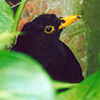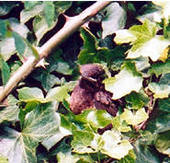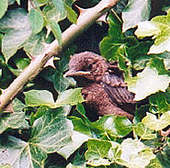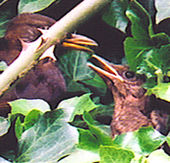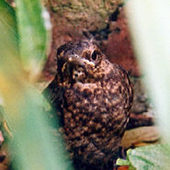Blackbirds (Turdus merula) have built nests in this Yorkshire garden, usually in the ivy, most years. Other species have nested here, but none as frequently as the blackbirds. There are sometimes two broods from the blackbird pair in the course of one year.
Unfortunately most of the young birds don't survive, as they are caught by cats, and on at least one occasion it appeared that one had been taken by a sparrowhawk. I do my best to keep our cat Rosie indoors when I know that young birds are emerging from the nest.
The photos on this page show the first blackbird brood of 2002, the day the fledglings began to appear from the nest, hidden in the ivy on the garden wall. I don't usually see the birds emerging, but on this occasion was around on the day they flew, and hung around on a ladder nearby for much of the afternoon to bring you these pictures. (It's funny what you end up doing, when you've got a website about your garden.)
Collecting materials
It's always entertaining watching the blackbirds collecting nesting materials. Most memorable, one spring, was watching a female blackbird tugging repeatedly at the foliage of dwarf irises. These leaves are long and grassy, and probably suitably pliable for building into a nest. Unfortunately they were still attached to the bulbs.
Helping out
There were ways to help this frantic blackbird and other birds in their
nest-making. As I was tidying up the garden I left a small pile of dried
grass, twigs and grass clippings near the pot of iris foliage she was
trying to get hold of. This succeeded in distracting her from my poor
besieged irises. On her next visit she switched her attention to some
of this stuff I'd put out, rifling through it like someone at a jumble
sale, and then flying up into the ivy with some of the grass clippings.
Similarly, when I got around to emptying the half-rotted compost out of
the compost bin, I left some of it on the ground near to her nesting site,
so she could pick over that too, which she did with great gusto.
My reading up on birds and their nesting suggested that the blackbird
may need mud for nest building. After a week of dry weather there wasn't
much mud around, until I watered in some plants I'd just planted out,
and she appeared as soon as I moved away, gathering mud from these newly
wet areas.
Garden vandalism . . .
The following day I found wet compost all over the paths, as she'd gone
through all my watered pots, and pulled out the top layers. Rather a messy
scene.
I had to accept this as all part of the rich and varied - and often messy
- experience that is `wildlife-friendly' gardening . . . And worth it
when the young blackbirds come out of the nest and are hopping all over
the garden.
Websites giving advice on abandoned or injured birds:
Bird rescue (UK)
Starling Talk
(US)

